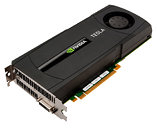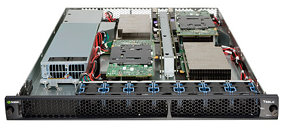Monday, November 16th 2009

New NVIDIA Tesla GPUs Reduce Cost Of Supercomputing By A Factor Of 10
NVIDIA Corporation today unveiled the Tesla 20-series of parallel processors for the high performance computing (HPC) market, based on its new generation CUDA processor architecture, codenamed "Fermi".
Designed from the ground-up for parallel computing, the NVIDIA Tesla 20-series GPUs slash the cost of computing by delivering the same performance of a traditional CPU-based cluster at one-tenth the cost and one-twentieth the power.The Tesla 20-series introduces features that enable many new applications to perform dramatically faster using GPU Computing. These include ray tracing, 3D cloud computing, video encoding, database search, data analytics, computer-aided engineering and virus scanning.
"NVIDIA has deployed a highly attractive architecture in Fermi, with a feature set that opens the technology up to the entire computing industry," said Jack Dongarra, director of the Innovative Computing Laboratory at the University of Tennessee and co-author of LINPACK and LAPACK.
The Tesla 20-series GPUs combine parallel computing features that have never been offered on a single device before. These include:
"There can be no doubt that the future of computing is parallel processing, and it is vital that computer science students get a solid grounding in how to program new parallel architectures," said Dr. Wen-mei Hwu, Professor in Electrical and Computer Engineering of the University of Illinois at Urbana-Champaign. "GPUs and the CUDA programming model enable students to quickly understand parallel programming concepts and immediately get transformative speed increases."
The family of Tesla 20-series GPUs includes:
As previously announced, the first Fermi-based consumer (GeForce) products are expected to be available first quarter 2010.
Designed from the ground-up for parallel computing, the NVIDIA Tesla 20-series GPUs slash the cost of computing by delivering the same performance of a traditional CPU-based cluster at one-tenth the cost and one-twentieth the power.The Tesla 20-series introduces features that enable many new applications to perform dramatically faster using GPU Computing. These include ray tracing, 3D cloud computing, video encoding, database search, data analytics, computer-aided engineering and virus scanning.
"NVIDIA has deployed a highly attractive architecture in Fermi, with a feature set that opens the technology up to the entire computing industry," said Jack Dongarra, director of the Innovative Computing Laboratory at the University of Tennessee and co-author of LINPACK and LAPACK.
The Tesla 20-series GPUs combine parallel computing features that have never been offered on a single device before. These include:
- Support for the next generation IEEE 754-2008 double precision floating point standard
- ECC (error correcting codes) for uncompromised reliability and accuracy
- Multi-level cache hierarchy with L1 and L2 caches
- Support for the C++ programming language
- Up to 1 terabyte of memory, concurrent kernel execution, fast context switching, 10x faster atomic instructions, 64-bit virtual address space, system calls and recursive functions
"There can be no doubt that the future of computing is parallel processing, and it is vital that computer science students get a solid grounding in how to program new parallel architectures," said Dr. Wen-mei Hwu, Professor in Electrical and Computer Engineering of the University of Illinois at Urbana-Champaign. "GPUs and the CUDA programming model enable students to quickly understand parallel programming concepts and immediately get transformative speed increases."
The family of Tesla 20-series GPUs includes:
- Tesla C2050 & C2070 GPU Computing Processors
- Single GPU PCI-Express Gen-2 cards for workstation configurations
- Up to 3GB and 6GB (respectively) on-board GDDR5 memory
- Double precision performance in the range of 520GFlops - 630 GFlops
- Tesla S2050 & S2070 GPU Computing Systems
- Four Tesla GPUs in a 1U system product for cluster and datacenter deployments
- Up to 12 GB and 24 GB (respectively) total system memory on board GDDR5 memory
- Double precision performance in the range of 2.1 TFlops - 2.5 TFlops
As previously announced, the first Fermi-based consumer (GeForce) products are expected to be available first quarter 2010.


53 Comments on New NVIDIA Tesla GPUs Reduce Cost Of Supercomputing By A Factor Of 10
I wouldn't touch that Avivo transcoder with a 10 foot pole, don't tempt me :laugh:
Edit: you temped to download that thing lol :roll:
Interesting enough that PoS finally does what it claims to do, it actually loads the GPU @11~17% in pulses.
It is common sense to know that the 40nm yields are not good, simply by looking at the supply (or the lack) of the 5800 series.
It is TSMC that makes their graphics chips, and it is the same comapny that makes graphics chips for nVidia.:slap:
The actual cards are make by their AIBs, companies like Sapphire (PC Partner) are the ones that actually make the cards.
AMD is a fabless company just like nVidia is now.
Globalfoundries and their Fabs were never invloved.:pimp:
What can be tell from this is, the Fermi's larger die size won't make their yields any better than the Cypress.
So unless TSMC gets their yields up, don't expect a sufficient supply of Fermi(s).
edit: it's not even a photo .. it's renderednotafaik it means that the gpu architecture is able to address up to 1 tb of memory .. like 32-bit -> 64-bit*ATI Lol's while they release HD 5870x2 and have all the shares on there highest end series while everybody goes broke for shiat*
The ratio between single and double precision performance is ~0.083
And :No one surprise that this card single precision performance is ~4.7 TFLOPS!? (570GFLOPS*0.083)
forums.techpowerup.com/showpost.php?p=1638260&postcount=114
And HD5970 has the same compute performance!
>.>
Don't let the numbers fool you in comparison to GTX285 or Ati cards either, GTX285 numbers are based on dual-issue, something that was never usable, real FP was more like 650 Gflops on the GTX285. Nvidia/Ati Gflops numbers don't correlate either, if 650 Gflps GTX285 is still significantly faster than the 1360 Gflops HD4890, the Fermi with 1260 is going to be significantly faster than the 2700 GFlops HD5870. Tesla cards are usually underclocked in comparison to desktop GPUs AFAIK, so this 520-630 DP numbers on the teslas could be the testimony of the power of the GTX380.
It is still too early to say before we even see a Engineering Sample in action.
If nVidia somehow and for some reason go for a SIMD architecture, the theoretical limit will sky rocket just like the RV7X0. :rolleyes:
All we have are some vague numbers that doesn't mean too much yet.
It is well possible that the Fermi is more optimized in GPGPU than its predecessors, afterall this is where the big bucks are.
I am more interested in the Graphics performance of a GPU, but this thread is about the new Tesla so I guess I am off topic.
The thing is out of 100 people, how many know what a "5 ALU wide VLIW SP" means?
Very very few companies are totally honest in marketing.
White paper tells you what a product is suppose to do, but it won't tell you how exactly it executes them in the hardware level.
The specific design of the chip is worth millions if not billions of dollars.
Since you mentioned the GTX380, GPGPU performance don't directly transfers to gamming performance.
It's not Ati's fault the F@H team can't put their thinking caps on and write a half-decent client program...
I'm not compating the SPs to x86 cores in any way, I don't know how did you come up to that conclusion.
Because of the VLIW nature of the SPs you could potentially make an engine that only works with 5 wide VLIW instructions and then you could potentially fill all the "cores", but that engine would not work on Nvidia cards or pre R600 Ati cards, not to mention it would not be profitable to do so and DirectX has no such functionality so you would have to make your engine entirely on HLSL. Still filling the 5 ALUs with something relevant to do would be very very difficult.
perspectives.mvdirona.com/2009/03/18/HeterogeneousComputingUsingGPGPUsAMDATIRV770.aspxOn general computing you will not see that typical usage of 4.2 and will be closer to 1 most times than not and hence the real Gflops on the Ati cards with this design is 1/5th or 2/5th of the peak throughoutput.
Also when a special function must be calculated you loose one of those ALUs (the fat one) for many clocks (probably you loose the entire SP), whereas the Nvidia card can do both the SF and the ALU operation and this is not the famous dual-issue, it can always be done as long as the SF function and the thread being executed in the ALUs were issued in a different clock.
That was a really insightful article, thanks. Still what I was trying to say was that if there's a will, there's always a way. As you said it yourself, you need to code specifically for ati's architecture and that could mean a seperate executable. I'm not saying that game companies should invest their own time and money to code a game specifically for ati users, no they shoudn't. If ati wants to have better support for their cards, they should sponsor game manufacturers just like nvidia does. Still there is nothing stopping a non-profit organisation like F@H to actually try and use all that computing power avaible to them...
A lot can be said about a bus with 50 seats being a more efficient and powerful way of transportation than a mini-bus with 12 seats, but if your working flow is go to town A -> take up 10 people -> go to B -> 10 people down/another 10 up -> go to C -> 10 leave/10 up and so on, your 50 seat bus is much less efficient than the mini-bus, and there's very little you can do about that. And there's very little the passengers (=software) can do on their front too.
* I'm talking about the ILP (Instruction Level Parallelism) and TLP (Thread level) both at the same time. Ati architecture needs both to be effective (because SIMD+VLIW) and that's a luxury you will not find in general computing quite often.